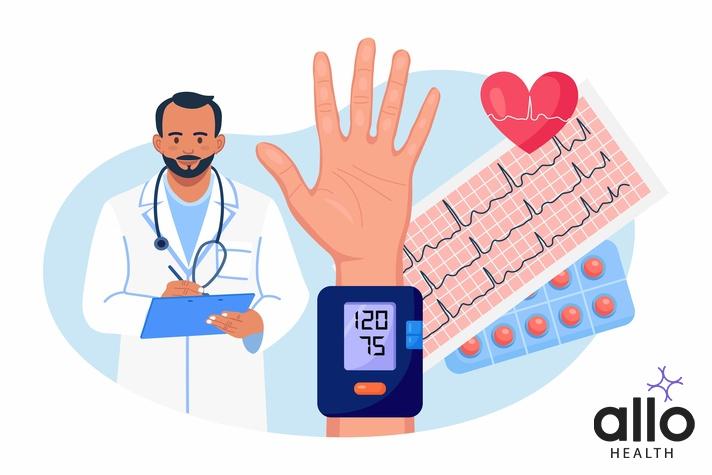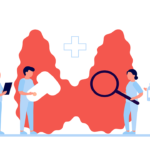All About An Autonomic Arousal

Allo Health is dedicated to personalized well-being, offering support and trusted information tailored to individual health goals. The platform emphasizes human-generated content, led by a distinguished medical team of experts, including physicians and sexual health specialists. Their commitment to credibility involves rigorous fact-checking, authoritative research, and continuous updates to ensure accurate, up-to-date information. Allo Health's unique approach goes beyond conventional platforms, providing expert-led insights and a continuous commitment to excellence, with user feedback playing a crucial role in shaping the platform's authoritative voice.

Dr. Aditi completed her undergraduate medical education at AJIMS, Mangalore, after which she worked in multi-speciality hospitals with COVID patients and in the Pain and Palliative medicine department. Driven by her experiences, she developed a keen interest in psychiatry. Dr. Aditi believes that mental health is just as, if not more important, than physical health.
Why This Was Upated?
Our experts continually monitor the health and wellness space, and we update our articles when new information became available.
Updated on 26 February, 2024
- Article was updated as part of our commitment to diversity, equity, and inclusion.

"The following blog article provides general information and insights on various topics. However, it is important to note that the information presented is not intended as professional advice in any specific field or area. The content of this blog is for general educational and informational purposes only.
Book consultation
The content should not be interpreted as endorsement, recommendation, or guarantee of any product, service, or information mentioned. Readers are solely responsible for the decisions and actions they take based on the information provided in this blog. It is essential to exercise individual judgment, critical thinking, and personal responsibility when applying or implementing any information or suggestions discussed in the blog."
Dive into the intricate realm of autonomic arousal, a physiological response that regulates vital functions. Uncover its significance, triggers, and implications for mental and physical well-being. This exploration sheds light on the interconnectedness of our autonomic nervous system, offering insights into stress, emotional responses, and overall health. Embark on a journey to understand the intricate mechanisms governing our body’s automatic reactions and their impact on daily life.
What is Autonomic Arousal and How Does it Work?
- Autonomic arousal is the body’s automatic response to stress or danger.
- Governed by the autonomic nervous system (ANS), comprising sympathetic and parasympathetic branches.
- Sympathetic activation triggers the “fight or flight” response, releasing adrenaline.
- Parasympathetic activation promotes relaxation, aiding in recovery.
- ANS balance is crucial for overall well-being, impacting heart rate, digestion, and more.
- Understanding autonomic arousal aids in managing stress and maintaining a healthy physiological state.
The Role of the Autonomic Nervous System in Arousal
– Sympathetic Arousal: Activates “fight or flight” response
– Parasympathetic Arousal: Induces relaxation and slows heart rate
– Vagal Tone: Reflects parasympathetic activity, crucial for emotional regulation
– Cardiac Arousal: Influences heart function, impacting overall arousal levels
– Respiratory Arousal: Alters breathing patterns, linked to stress or any generalized anxiety disorder, or any other anxiety symptoms.
– Gastrointestinal Arousal: Affects digestive processes, influenced by the autonomic system
– Pupillary Arousal: Changes in pupil size, indicative of autonomic response
– Genital Arousal: Involves sexual response, influenced by autonomic nervous system dynamics. Understanding these types aids in comprehending the body’s intricate autonomic regulation.
The Different Types of Autonomic Arousal

- Sympathetic Nervous System Activation: “Fight or flight” response, increases heart rate and alertness.
- Parasympathetic Nervous System Activation: Promotes relaxation, slows heart rate, and aids digestion.
- Vagal Tone: Reflects parasympathetic influence on the heart, crucial for emotional regulation.
- Emotional Arousal: Triggered by emotions, impacting autonomic functions.
- Exercise-induced Arousal: Physical activity activates sympathetic response, enhancing performance.
- Stress Response: Psychological stress prompts autonomic changes, affecting various bodily functions.
- Respiratory Arousal: Breathing patterns influence autonomic balance, affecting overall arousal levels.
- Cardiovascular Arousal: Changes in blood pressure, heart rate, and vascular tone linked to autonomic activity.
- Temperature Regulation: The autonomic system helps regulate body temperature in response to environmental factors.
- Sleep-wake Cycle: Autonomic modulation plays a role in circadian rhythms, impacting arousal levels. Understanding these autonomic arousal types provides insights into physiological responses and overall well-being.
How Does Autonomic Arousal Affect Our Body and Mind?
- Autonomic arousal is the automatic response of the nervous system.
- Physiological changes include increased heart rate, sweating, and pupil dilation.
- Influences emotional states, stress levels, and cognitive performance.
- Fight-or-flight response activates in stressful situations.
- Can impact digestion, immune system, and overall well-being.
- Mind-body connection underscores the significance of managing autonomic arousal for holistic health.
Signs and Symptoms of Autonomic Arousal
Some various signs and symptoms can indicate you are experiencing autonomic arousal, including:
- Rapid heart rate
- Sweating
- Trembling or shaking
- Shortness of breath
- Digestive concerns
- Insomnia
- Irritability or anger
It is important to note that autonomic arousal can be a normal response to stress or danger, but if it occurs frequently or without an obvious trigger, it may be a sign of an underlying anxiety disorder. Seeking professional help can assist in managing and treating these symptoms.
What Triggers Autonomic Arousal and How to Manage It?

- Triggers: Stress, anxiety, fear, and intense emotions
- Physical triggers: Exercise, caffeine, and certain medications
- Symptoms: Increased heart rate, sweating, dilated pupils
- Management: Deep breathing, mindfulness, progressive muscle relaxation
- Exercise: Regular physical activity helps regulate autonomic arousal
- Lifestyle changes: Adequate sleep, balanced diet, and hydration
- Professional help: Counseling, therapy, and stress management techniques
- Medication: In severe cases, prescribed medications may be considered
- Holistic approaches: Yoga, meditation, and biofeedback for overall well-being.
The Connection Between Autonomic Arousal and Mental Health
- Autonomic arousal, linked to the sympathetic nervous system, influences mental health.
- High arousal levels may contribute to anxiety and stress disorders.
- Chronic autonomic dysregulation can impact mood, exacerbating depression.
- Understanding heart rate variability offers insights into autonomic function.
- Mind-body interventions like mindfulness and yoga can modulate autonomic responses.
- Balancing autonomic arousal is crucial for overall mental well-being.
- Research explores the intricate relationship between autonomic activity and mental health.
- Personalized interventions targeting autonomic regulation hold promise in mental health care.
Treatment Options for Autonomic Arousal Disorders
There are various treatment options available for autonomic arousal disorders, including medication, psychotherapy, cognitive-behavioral therapy (CBT), and exposure therapy. These options can help alleviate symptoms and improve the quality of life for individuals experiencing prolonged or excessive autonomic arousal.
Medication is often used to treat autonomic arousal disorders, such as beta-blockers, which can help reduce heart rate and blood pressure. Antidepressants and anti-anxiety medications may also be prescribed to help manage symptoms of anxiety and panic attacks.
Psychotherapy, such as talk therapy, can help individuals with autonomic arousal disorders learn coping mechanisms and relaxation techniques to manage their symptoms. Cognitive-behavioral therapy (CBT) can also be effective in changing negative thought patterns and behaviors that contribute to autonomic arousal.
Self-Care Techniques to Manage Autonomic Arousal
In addition to seeking professional help, various self-care techniques can help manage autonomic arousal. These include:
- Engaging in regular exercise or physical activity
- Maintaining a healthy diet
- Practicing relaxation techniques such as deep breathing or meditation
- Making time for enjoyable activities or hobbies
- Getting adequate sleep
- Reducing exposure to stressful situations or stimuli
It is important to note that self-care techniques may not work for everyone and should not be used as a substitute for professional help. It is recommended to consult with a healthcare provider or mental health professional to determine the best course of treatment for managing autonomic arousal.
Understanding the Link Between Autonomic Arousal and Trauma
- Unravel the connection between autonomic arousal and trauma
- Explore how traumatic experiences impact the body’s autonomic nervous system
- Understand the role of fight-or-flight responses in trauma
- Gain insights into potential therapeutic interventions for trauma-related autonomic dysregulation.
How to Prevent Chronic Activation of the Autonomic Nervous System
- Practice stress-reduction techniques: Incorporate meditation, deep breathing, or yoga into your routine.
- Maintain a balanced lifestyle: Adequate sleep, regular exercise, and a healthy diet promote autonomic nervous system balance.
- Identify and manage triggers: Recognize stressors and develop coping strategies to minimize their impact.
- Foster social connections: Cultivate supportive relationships to enhance emotional well-being and reduce chronic stress.
- Limit stimulant intake: Reduce caffeine, nicotine, and other painful stimuli consumption to prevent prolonged sympathetic nervous system activation.
- Prioritize relaxation: Engage in activities like reading, listening to music, or taking leisurely walks to counteract chronic stress.
- Seek professional guidance: Consult healthcare professionals for personalized strategies to prevent and manage autonomic nervous system dysfunction.
- Establish a consistent routine: Regular daily habits contribute to stability, aiding in the prevention of chronic autonomic nervous system activation.
The Relationship Between Sleep and Autonomic Arousal
- Autonomic Arousal Overview:
- Autonomic arousal refers to the involuntary physiological responses regulated by the autonomic nervous system.
- It involves functions like heart rate, blood pressure, and respiratory rate.
- Sleep Impact on Autonomic Arousal:
- Sleep plays a crucial role in modulating autonomic arousal patterns.
- Different sleep stages influence sympathetic and parasympathetic activity.
- REM Sleep and Autonomic Activity:
- Rapid Eye Movement (REM) sleep is associated with increased sympathetic nervous system activity.
- Elevated heart rate and irregular breathing characterize this stage.
- Non-REM Sleep and Autonomic Changes:
- Non-REM sleep exhibits a shift towards parasympathetic dominance.
- Slower heart rate and more regular breathing patterns are observed.
- Sleep Disorders and Autonomic Dysfunction:
- Conditions like insomnia or sleep apnea can disrupt the autonomic balance.
- Chronic sleep disturbances may contribute to cardiovascular concerns.
- The Bidirectional Influence:
- Autonomic arousal disturbances can disrupt sleep architecture.
- Poor sleep quality may, in turn, exacerbate autonomic dysfunction.
- Clinical Implications:
- Understanding the sleep-autonomic relationship is crucial in managing conditions like hypertension and cardiovascular diseases.
- Sleep interventions may complement treatments targeting autonomic dysregulation.
The Importance of Seeking Professional Help for Managing Autonomic Arousal
- Recognizing autonomic arousal: Understand signs of heightened physiological responses.
- Impact on mental health: Unmanaged arousal can contribute to generalized anxiety disorders, stress, and other mental disorders.
- Professional assessment: Seek expert evaluation to determine the root causes and severity.
- Tailored interventions: Professionals devise personalized strategies for managing autonomic arousal.
- Psychoeducation: Gain insights into the physiological and psychological aspects of arousal.
- Therapeutic techniques: Professionals employ evidence-based therapies for effective arousal regulation.
- Holistic approach: Comprehensive support addressing both mental and physical well-being.
- Long-term benefits: Seeking professional help ensures sustained management and improved overall health.
Autonomic arousal is a natural response to stress, danger, or excitement. However, chronic or excessive autonomic arousal can lead to physical and emotional concerns.
Understanding your triggers and developing effective coping mechanisms can help manage and reduce your autonomic arousal response. Additionally, seeking professional help and prioritizing self-care activities can improve overall mental health and well-being.
By taking control of your body’s automatic response, you can lead a happier, healthier life.
It is important to note that everyone’s autonomic arousal response is unique and can vary in intensity. Some people may experience more severe physical symptoms, such as heart palpitations or sweating, while others may experience more emotional symptoms, such as anxiety or irritability.
It is also important to recognize that autonomic arousal can be triggered by both positive and negative events. While stress and danger are common triggers, excitement, and anticipation can also lead to increased autonomic arousal.
By becoming more aware of your own unique autonomic arousal response and learning to manage it effectively, you can improve your overall quality of life and reduce the negative impact of chronic stress on your physical and emotional health.
Most Asked Questions
-
What is Autonomic Arousal?
Autonomic arousal refers to the body's automatic response to stress or threat. It involves the autonomic nervous system, regulating functions like heart rate, breathing, and digestion.
-
How Does Trauma Impact Autonomic Arousal?
Traumatic experiences can dysregulate the autonomic nervous system. Individuals may experience heightened arousal, leading to anxiety, panic attacks, or other stress-related symptoms.
-
What Are Common Symptoms of Autonomic Dysregulation?
Symptoms include increased heart rate, sweating, shallow breathing, and digestive concerns. Chronic autonomic dysregulation may contribute to long-term health concerns.
-
Can Autonomic Arousal Be Managed or Controlled?
Various therapeutic approaches, including mindfulness and biofeedback, can help regulate autonomic arousal. Understanding triggers and coping mechanisms is crucial for effective management.
-
Are There Links Between Autonomic Arousal and Mental Health?
Yes, autonomic dysregulation is often associated with mental health disorders. Addressing autonomic arousal can be a key aspect of comprehensive mental health treatment.






































